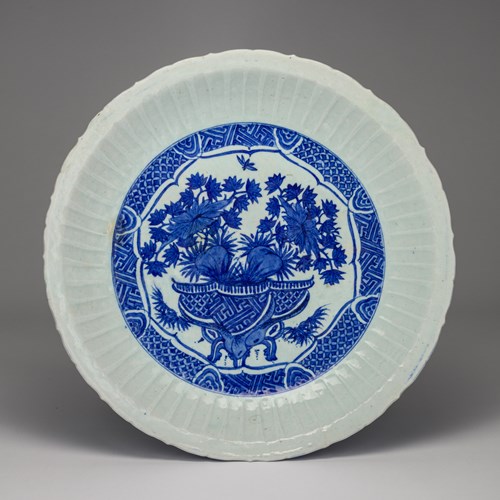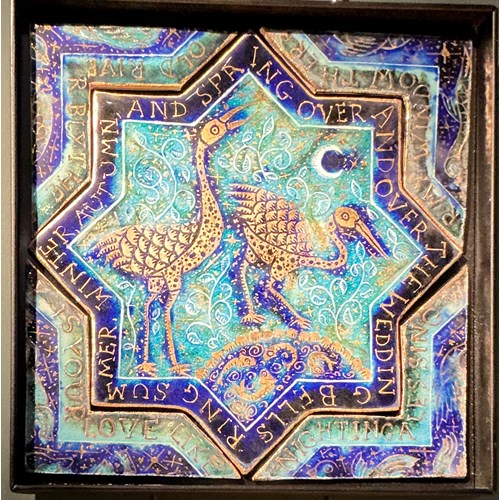Marketplace
A Bezoar Stone with Metal Mount
A Bezoar Stone with Metal Mount
Period 17th century, 18th century
Origin Probably Goa, India
Medium bezoar, Brass
Bezoar stones were very valuable medicinal products. A bezoar stone is a hardened mass of chewed hair formed in the stomach of a bezoar goat - of Persian origin. Since medieval times, people have believed that these stones were endowed with healing properties, and they were used mainly as an antidote to poisoning by arsenic. ‘Smooth, lustrous, and dung-colored, bezoars range in size from pebbles to goose eggs. According to tradition, a bit of bezoar, scraped off and dissolved in wine or water, would banish fever, melancholia, even plague.’[1] The word bezoar is derived from the Persian pād-zahr (پادزهر), literally ‘antidote.’[2]
The use of bezoars was widespread during the sixteenth century, and their value was ten times more than their weight in gold.[3] The bezoar’s reputation as a panacea reached Europe through the writings of medieval Arab and Persian physicians like Ibn Sina and Ibn al-Beithar. Their reputation made them one of the most sought-after commodities on the market.[4]
The Jesuits developed a process for creating man-made bezoars, which were called “Goa stones.” The present example is likely to be one such stone. According to most of the recipes of man-made bezoar stones that have survived, these stones, spherical in shape and covered with gold leaf, were made from musk, oriental bezoar stones, ambergris, seed pearls, ground antelope or deer horn, terra sigillata, red and white coral, emerald, topaz, ruby, jacinth and sapphire. Used in moderation, and scraped, ground, diluted into elixirs or merely immersed in liquid, these valuable stones would occasionally be stored and displayed in their own precious boxes and containers, made from gold or silver. Smaller ones were incorporated into and worn as jewellery. Later they became key parts of cabinets of curiosities.
[1] https://daily.jstor.org/from-the-belly-of-a-goat-to-the-mouth-of-a-king/ (accessed 09/02/2023)
[2] https://www.etymonline.com/word/bezoar (accessed 09/02/2023)
[3]https://www.lyellcollection.org/doi/10.1144/sp375.11#:~:text=Bezoars were introduced into Western,than their weight in gold (accessed 09/02/2023)
[4] https://daily.jstor.org/from-the-belly-of-a-goat-to-the-mouth-of-a-king/ (accessed 09/02/2023)
Stock no.: A5468
The use of bezoars was widespread during the sixteenth century, and their value was ten times more than their weight in gold.[3] The bezoar’s reputation as a panacea reached Europe through the writings of medieval Arab and Persian physicians like Ibn Sina and Ibn al-Beithar. Their reputation made them one of the most sought-after commodities on the market.[4]
The Jesuits developed a process for creating man-made bezoars, which were called “Goa stones.” The present example is likely to be one such stone. According to most of the recipes of man-made bezoar stones that have survived, these stones, spherical in shape and covered with gold leaf, were made from musk, oriental bezoar stones, ambergris, seed pearls, ground antelope or deer horn, terra sigillata, red and white coral, emerald, topaz, ruby, jacinth and sapphire. Used in moderation, and scraped, ground, diluted into elixirs or merely immersed in liquid, these valuable stones would occasionally be stored and displayed in their own precious boxes and containers, made from gold or silver. Smaller ones were incorporated into and worn as jewellery. Later they became key parts of cabinets of curiosities.
[1] https://daily.jstor.org/from-the-belly-of-a-goat-to-the-mouth-of-a-king/ (accessed 09/02/2023)
[2] https://www.etymonline.com/word/bezoar (accessed 09/02/2023)
[3]https://www.lyellcollection.org/doi/10.1144/sp375.11#:~:text=Bezoars were introduced into Western,than their weight in gold (accessed 09/02/2023)
[4] https://daily.jstor.org/from-the-belly-of-a-goat-to-the-mouth-of-a-king/ (accessed 09/02/2023)
Stock no.: A5468
Period: 17th century, 18th century
Origin: Probably Goa, India
Medium: bezoar, Brass
More artworks from the Gallery









